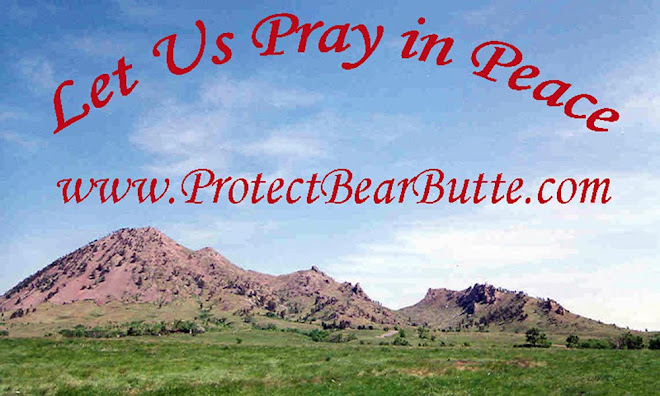Bear Butte Mountain: A beautiful, sacred site in South Dakota
By Vincent Schilling, Today correspondent
Story Published: Apr 7, 2009
Story Updated: Apr 3, 2009
STURGIS, S.D. – Just outside Sturgis is the Sacred Mato Paha or Bear Butte Mountain. Bear Butte, a 4,426-foot mountain, rests on the northernmost part of the Black Hills. It has been a sacred site to the Northern Plains Indians for thousands of years.
Today, Bear Butte Mountain attracts visitors from all over the world. Bear Butte is still a place for traditional American Indian ceremonies. When hiking up the mountain on designated trails, it’s common to see trees bestowed with sacred tobacco offerings wrapped in colorful cloth as representations of prayers to the Creator.
According to a Lakota story, long ago a giant bear and a water monster similar to a dinosaur, battled for many days and nights. Because of the fierce battle, valleys filled with blood. The giant bear was wounded by the sea monster’s jagged teeth and the bear crawled away to die. The ground erupted, darkness covered the earth, and fire, ashes, water and mud went into the sky.
“You cannot take away the spirituality of this mountain, which is its true draw. That is its true magnificence. For everybody that comes here, I believe it is different. No two people that come here have the same experience.”
-- Jim Jandreau, Bear Butte Park manager
The story continues with the bear’s body disappearing, and in place of the bear was a hill in the shape of the bear’s sleeping body which continued to rumble and smolder.
To the native Lakota, Bear Butte has long been a place to hold council meetings and ceremonies such as vision quests and Sun dances. In the mid-1800s the father of Crazy Horse, a great holy man, climbed Bear Butte to seek spiritual guidance on a vision quest.
It has been said that Wakantanka appeared before the holy man in the form of a bear and gave him power to overcome obstacles and defeat his enemies. Crazy Horse’s father asked that the same gifts also be given to his son. After this bestowment, the mountain was known as Bear Butte or Mata Paha.
The history of Bear Butte is rich, as well as literal, artifacts dating back 10,000 years have been discovered near it. Tipi rings have been found along Bear Butte’s perimeter, as well as rocks the Sioux once placed along the mountain’s summit to establish claims to the land, to mark distance
or to offer prayers.
Many note a profound spiritual connection when visiting the site.
Jim Jandreau, who was born and raised on the Lower Brule Sioux in South Dakota is the first American Indian park manager at Bear Butte State park. Jandreau admits that although the sites of Bear Butte are majestic, the profound connection to spiritual matters are much more prevalent.
“You cannot take away the spirituality of this mountain, which is its true draw. That is its true magnificence. For everybody that comes here, I believe it is different. No two people that come here have the same experience.”
Jandreau said Bear Butte is open to anyone who wishes to visit.
“The medicine men that practice here and bring their people here to worship will all tell you that this mountain is not exclusive to only Indian people praying. Anybody who comes in the right mind and the right heart with prayer on their lips, with humbleness is welcome. When you go to that area with that humbleness then we are all truly equal.”
Bear Butte has long been the subject of preserving sacred sites by American Indian artists. Award-winning American Indian musician Michael Bucher, Cherokee, whose song off his “Seven” album entitled “Dirty Water” fights for the preservation of the site.
“I went to Bear Butte Mountain and climbed along the trails to look at the view and to feel the sanctity of the place. You can see buffalo at the base of Bear Butte and see prayer flags all over the trees. They are tobacco cloth offerings. Some of the multi-colored ribbons are old and faded and some of the flags are on trees that have been uprooted by the weather. It all adds to the holiness of the place that so many prayers for hundreds of years have been prayed there,”
Bucher said.
Both Bucher and Jandreau said that though visitors may go for the simple beauty of Bear Butte or to hike the trails that were once traversed by Indian people so many years ago, visitors leave with much more than they may have anticipated.
“Everyone that comes off this mountain, it doesn’t matter if they are Indian or non-Indian or what tribe they are from, when they come away from this mountain, and go to see that medicine man interpreter about their vision, none of them will ever be the same,” Jandreau said. “People who come here are changed spiritually and morally. They may not know it when they drive out of the gate, but that stays with them.”
Tuesday, April 7, 2009
Subscribe to:
Post Comments (Atom)




No comments:
Post a Comment